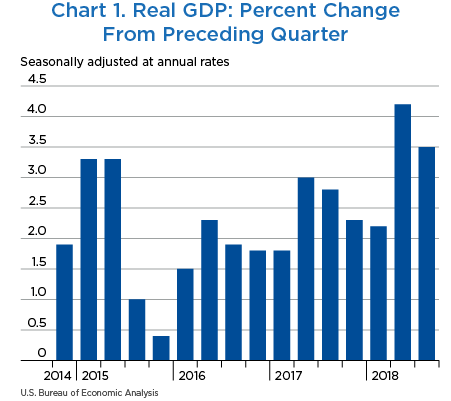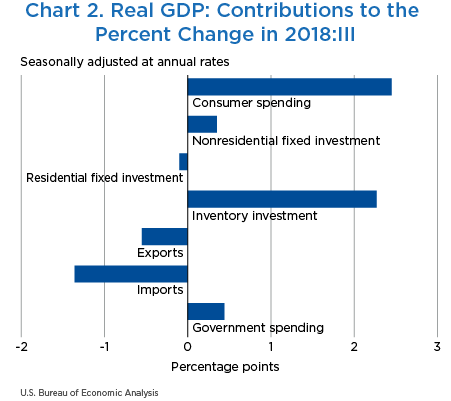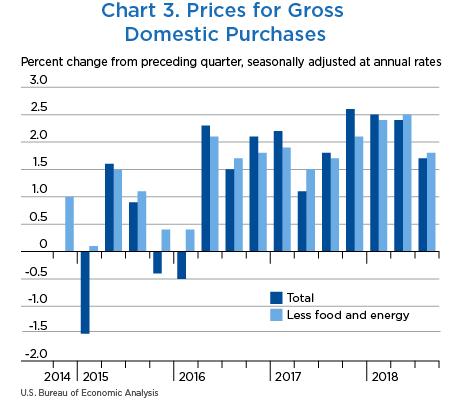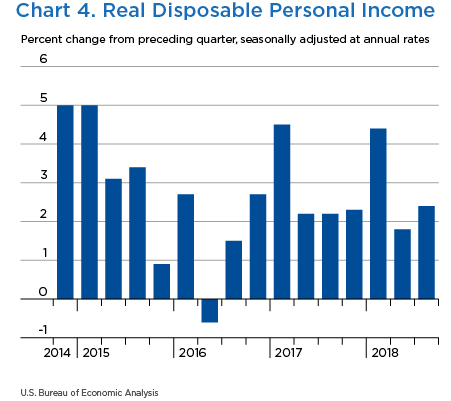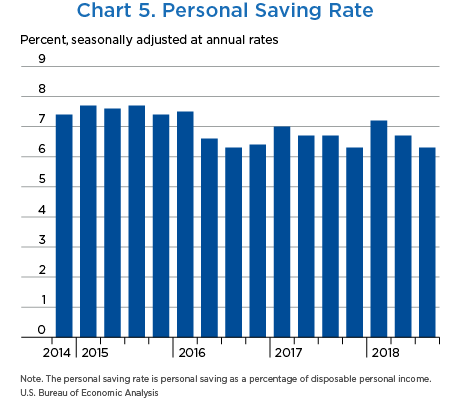GDP and the Economy
Second Estimates for the Third Quarter of 2018
Real gross domestic product (GDP) increased at an annual rate of 3.5 percent in the third quarter of 2018, according to the second estimate of the National Income and Product Accounts (NIPAs) (chart 1 and table 1).1 With the second estimate, real GDP growth for the third quarter was unrevised from the advance estimate issued last month (see “Revisions” below). In the second quarter, real GDP increased 4.2 percent.
The increase in real GDP in the third quarter reflected positive contributions from increases in consumer spending, inventory investment, nonresidential fixed investment, federal government spending, and state and local government spending that were partly offset by negative contributions from decreases in exports and in residential fixed investment. Imports, which are a subtraction in the calculation of GDP, increased (chart 2).2
The deceleration in real GDP growth in the third quarter primarily reflected a downturn in exports (line 16) and decelerations in nonresidential fixed investment (line 9) and in consumer spending (line 2). Additionally, imports increased in the third quarter after decreasing in the second (line 19). These movements were partly offset by an upturn in nonfarm inventory investment (line 14).
- The downturn in exports (line 16) primarily reflected downturns in foods, feeds, and beverages (mainly soybeans), in petroleum and products, and in nonautomotive capital goods.
- The deceleration in nonresidential fixed investment (line 9) primarily reflected a downturn in investment in structures (line 10). Decelerations in intellectual property products (line 12) and in equipment (line 11) also contributed to this deceleration. The main contributor to the downturn in structures was investment in mining exploration, shafts, and wells, which turned down following strong second-quarter growth.
- The deceleration in consumer spending (line 2) reflected a deceleration in spending on durable goods (line 4) that was partly offset by accelerations in nondurable goods (line 5) and in services (line 6). The deceleration in durable goods was mainly due to a downturn in motor vehicles and parts.
- The upturn in imports (line 19) was mostly accounted for by upturns in imported consumer durable goods (nonfood, nonautomotive) and in automotive vehicles, engines, and parts.
- The upturn in nonfarm inventory investment (line 14) was widespread across most industries. The leading contributors were the wholesale trade and manufacturing industries.
| Line | Share of current-dollar GDP (percent) | Change from preceding period (percent) | Contribution to percent change in real GDP (percentage points) | |||||||
|---|---|---|---|---|---|---|---|---|---|---|
| 2018 | 2017 | 2018 | 2017 | 2018 | ||||||
| III | IV | I | II | III | IV | I | II | III | ||
| 1 | Gross domestic product1 | 100.0 | 2.3 | 2.2 | 4.2 | 3.5 | 2.3 | 2.2 | 4.2 | 3.5 |
| 2 | Personal consumption expenditures | 68.0 | 3.9 | 0.5 | 3.8 | 3.6 | 2.64 | 0.36 | 2.57 | 2.45 |
| 3 | Goods | 21.2 | 6.8 | −0.6 | 5.5 | 4.8 | 1.42 | −0.13 | 1.16 | 1.00 |
| 4 | Durable goods | 7.1 | 12.7 | −2.0 | 8.6 | 3.9 | 0.87 | −0.15 | 0.60 | 0.28 |
| 5 | Nondurable goods | 14.1 | 4.0 | 0.1 | 4.0 | 5.3 | 0.55 | 0.02 | 0.56 | 0.73 |
| 6 | Services | 46.8 | 2.6 | 1.0 | 3.0 | 3.1 | 1.22 | 0.49 | 1.42 | 1.45 |
| 7 | Gross private domestic investment | 18.0 | 0.8 | 9.6 | −0.5 | 15.1 | 0.14 | 1.61 | −0.07 | 2.52 |
| 8 | Fixed investment | 17.5 | 6.2 | 8.0 | 6.4 | 1.4 | 1.04 | 1.34 | 1.10 | 0.25 |
| 9 | Nonresidential | 13.6 | 4.8 | 11.5 | 8.7 | 2.5 | 0.63 | 1.47 | 1.15 | 0.35 |
| 10 | Structures | 3.1 | 1.3 | 13.9 | 14.5 | −1.7 | 0.04 | 0.40 | 0.43 | −0.05 |
| 11 | Equipment | 6.0 | 9.9 | 8.5 | 4.6 | 3.5 | 0.56 | 0.49 | 0.27 | 0.21 |
| 12 | Intellectual property products | 4.5 | 0.7 | 14.1 | 10.5 | 4.3 | 0.03 | 0.58 | 0.45 | 0.19 |
| 13 | Residential | 3.9 | 11.1 | −3.4 | −1.3 | −2.6 | 0.41 | −0.14 | −0.05 | −0.10 |
| 14 | Change in private inventories | 0.4 | ...... | ...... | ...... | ...... | −0.91 | 0.27 | −1.17 | 2.27 |
| 15 | Net exports of goods and services | −3.2 | ...... | ...... | ...... | ...... | −0.89 | −0.02 | 1.22 | −1.91 |
| 16 | Exports | 12.3 | 6.6 | 3.6 | 9.3 | −4.4 | 0.79 | 0.43 | 1.12 | −0.55 |
| 17 | Goods | 8.1 | 10.9 | 3.2 | 13.5 | −8.1 | 0.83 | 0.26 | 1.06 | −0.69 |
| 18 | Services | 4.2 | −1.0 | 4.2 | 1.5 | 3.4 | −0.04 | 0.18 | 0.07 | 0.14 |
| 19 | Imports | 15.4 | 11.8 | 3.0 | −0.6 | 9.2 | −1.68 | −0.45 | 0.10 | −1.36 |
| 20 | Goods | 12.6 | 14.2 | 2.4 | −0.4 | 10.3 | −1.62 | −0.30 | 0.06 | −1.23 |
| 21 | Services | 2.9 | 2.0 | 5.5 | −1.4 | 4.6 | −0.06 | −0.15 | 0.04 | −0.13 |
| 22 | Government consumption expenditures and gross investment | 17.2 | 2.4 | 1.5 | 2.5 | 2.6 | 0.41 | 0.27 | 0.43 | 0.44 |
| 23 | Federal | 6.4 | 4.1 | 2.6 | 3.7 | 3.5 | 0.26 | 0.17 | 0.24 | 0.23 |
| 24 | National defense | 3.8 | 2.9 | 3.0 | 5.9 | 4.9 | 0.11 | 0.11 | 0.22 | 0.18 |
| 25 | Nondefense | 2.6 | 5.7 | 2.1 | 0.5 | 1.5 | 0.15 | 0.06 | 0.01 | 0.04 |
| 26 | State and local | 10.8 | 1.4 | 0.9 | 1.8 | 2.0 | 0.15 | 0.10 | 0.20 | 0.22 |
| Addenda: | ||||||||||
| 27 | Gross domestic income (GDI)2 | ...... | 1.5 | 3.9 | 0.9 | 4.0 | ...... | ...... | ...... | ...... |
| 28 | Average of GDP and GDI | ...... | 1.9 | 3.1 | 2.5 | 3.8 | ...... | ...... | ...... | ...... |
| 29 | Final sales of domestic product | 99.6 | 3.2 | 1.9 | 5.4 | 1.2 | 3.20 | 1.94 | 5.33 | 1.23 |
| 30 | Goods | 29.4 | 1.1 | 4.1 | 6.5 | 6.2 | 0.34 | 1.20 | 1.91 | 1.81 |
| 31 | Services | 62.1 | 2.1 | 1.2 | 2.9 | 2.9 | 1.32 | 0.73 | 1.78 | 1.77 |
| 32 | Structures | 8.5 | 7.9 | 3.4 | 5.5 | −0.8 | 0.64 | 0.28 | 0.47 | −0.07 |
| 33 | Motor vehicle output | 2.8 | 23.2 | 9.5 | −5.8 | 9.9 | 0.58 | 0.26 | −0.17 | 0.26 |
| 34 | GDP excluding motor vehicle output | 97.2 | 1.8 | 2.0 | 4.5 | 3.3 | 1.72 | 1.96 | 4.33 | 3.24 |
- The GDP estimates under the contribution columns are also percent changes.
- GDI is deflated by the implicit price deflator for GDP. The second-quarter change in GDI reflects the incorporation of newly-available wage and salary estimates.
Note. Percent changes are from NIPA tables 1.1.1 and 1.2.1, contributions are from NIPA tables 1.1.2 and 1.2.2, and shares are from NIPA table 1.1.10 or are calculated from NIPA table 1.2.5.
Prices for gross domestic purchases, goods and services purchased by U.S. residents, increased 1.7 percent in the third quarter after increasing 2.4 percent in the second quarter (table 2, line 1, and chart 3). Food prices decelerated (line 20), increasing 0.5 percent after increasing 1.1 percent. Energy goods and services accelerated, increasing 3.4 percent after increasing 0.4 percent. Gross domestic purchases prices excluding food and energy (line 22) increased 1.8 percent after increasing 2.5 percent.
Consumer prices excluding food and energy (line 25), a measure of the “core” rate of inflation, decelerated, increasing 1.5 percent in the third quarter after increasing 2.1 percent in the second quarter.
| Line | Change from preceding period (percent) | Contribution to percent change in gross domestic purchases prices (percentage points) | |||||||
|---|---|---|---|---|---|---|---|---|---|
| 2017 | 2018 | 2017 | 2018 | ||||||
| IV | I | II | III | IV | I | II | III | ||
| 1 | Gross domestic purchases1 | 2.6 | 2.5 | 2.4 | 1.7 | 2.6 | 2.5 | 2.4 | 1.7 |
| 2 | Personal consumption expenditures | 2.7 | 2.5 | 2.0 | 1.5 | 1.81 | 1.63 | 1.32 | 0.99 |
| 3 | Goods | 1.5 | 2.2 | 0.4 | −0.4 | 0.30 | 0.46 | 0.08 | −0.07 |
| 4 | Durable goods | −2.2 | −1.1 | −1.6 | −0.9 | −0.16 | −0.07 | −0.11 | −0.06 |
| 5 | Nondurable goods | 3.4 | 3.9 | 1.4 | 0.0 | 0.46 | 0.53 | 0.19 | −0.01 |
| 6 | Services | 3.3 | 2.6 | 2.7 | 2.3 | 1.50 | 1.17 | 1.24 | 1.06 |
| 7 | Gross private domestic investment | 1.3 | 2.5 | 3.1 | 2.0 | 0.22 | 0.42 | 0.53 | 0.34 |
| 8 | Fixed investment | 1.2 | 2.5 | 3.2 | 2.0 | 0.21 | 0.42 | 0.53 | 0.33 |
| 9 | Nonresidential | 0.7 | 0.7 | 2.0 | 1.5 | 0.09 | 0.09 | 0.26 | 0.20 |
| 10 | Structures | 2.3 | 3.2 | 5.1 | 3.1 | 0.07 | 0.09 | 0.15 | 0.09 |
| 11 | Equipment | −0.5 | −0.3 | 0.8 | 1.1 | −0.03 | −0.02 | 0.05 | 0.07 |
| 12 | Intellectual property products | 1.2 | 0.4 | 1.4 | 0.9 | 0.05 | 0.02 | 0.06 | 0.04 |
| 13 | Residential | 3.1 | 8.8 | 7.3 | 3.6 | 0.11 | 0.32 | 0.27 | 0.13 |
| 14 | Change in private inventories | ...... | ...... | ...... | ...... | 0.02 | 0.01 | −0.01 | 0.01 |
| 15 | Government consumption expenditures and gross investment | 3.2 | 2.9 | 3.3 | 2.5 | 0.53 | 0.48 | 0.55 | 0.41 |
| 16 | Federal | 1.3 | 1.8 | 2.0 | 1.5 | 0.08 | 0.11 | 0.13 | 0.10 |
| 17 | National defense | 1.2 | 1.4 | 1.3 | 1.2 | 0.05 | 0.05 | 0.05 | 0.04 |
| 18 | Nondefense | 1.4 | 2.4 | 3.0 | 2.1 | 0.04 | 0.06 | 0.08 | 0.05 |
| 19 | State and local | 4.4 | 3.6 | 4.1 | 3.0 | 0.45 | 0.37 | 0.42 | 0.31 |
| Addenda: | |||||||||
| Gross domestic purchases: | |||||||||
| 20 | Food | 0.1 | 0.4 | 1.1 | 0.5 | 0.01 | 0.02 | 0.05 | 0.02 |
| 21 | Energy goods and services | 24.9 | 12.6 | 0.4 | 3.4 | 0.61 | 0.33 | 0.01 | 0.09 |
| 22 | Excluding food and energy | 2.1 | 2.4 | 2.5 | 1.8 | 1.95 | 2.19 | 2.33 | 1.62 |
| Personal consumption expenditures: | |||||||||
| 23 | Food and beverages purchased for off-premises consumption | 0.2 | 0.2 | 1.2 | 0.4 | ...... | ...... | ...... | ...... |
| 24 | Energy goods and services | 24.1 | 12.7 | 0.7 | 3.3 | ...... | ...... | ...... | ...... |
| 25 | Excluding food and energy | 2.1 | 2.2 | 2.1 | 1.5 | ...... | ...... | ...... | ...... |
| 26 | Gross domestic product | 2.5 | 2.0 | 3.0 | 1.7 | ...... | ...... | ...... | ...... |
| 27 | Exports of goods and services | 6.1 | 4.0 | 5.8 | 0.1 | ...... | ...... | ...... | ...... |
| 28 | Imports of goods and services | 5.7 | 7.3 | 0.8 | 0.5 | ...... | ...... | ...... | ...... |
- The estimates for gross domestic purchases under the contribution columns are also percent changes.
Note. Most percent changes are from NIPA table 1.6.7; percent changes for PCE for food and energy goods and services and for PCE excluding food and energy are from NIPA table 2.3.7. Contributions are from NIPA table 1.6.8. GDP, export, and import prices are from NIPA table 1.1.7.
Personal income (table 3, line 1), which is measured in current dollars, increased $174.9 billion in the third quarter after increasing $147.6 billion in the second quarter (revised). The acceleration in personal income primarily reflected accelerations in wages and salaries (line 3), rental income of persons (line 15), and nonfarm proprietors’ income (line 14) that were partly offset by a downturn in farm proprietors’ income (line 13) and a deceleration in personal income receipts on assets (line 16). Personal current taxes (line 29) increased $27.2 billion in the third quarter after increasing $5.3 billion in the second quarter.
Disposable personal income (DPI) (line 30 and chart 4) increased $147.7 billion in the third quarter after increasing $142.3 billion in the second quarter.
The personal saving rate (line 33 and chart 5)—personal saving as a percentage of DPI—was 6.3 percent in the third quarter; in the second quarter, the personal saving rate was 6.7 percent.
Real DPI (line 35) increased 2.4 percent in the third quarter after increasing 1.8 percent in the second quarter.
Current-dollar DPI (line 34) increased 3.9 percent after increasing 3.8 percent. The differences in the movements in real DPI and current-dollar DPI reflected a deceleration in the implicit price deflator for consumer spending, which is used to deflate DPI.
| Line | Level | Change from preceding period | |||||
|---|---|---|---|---|---|---|---|
| 2018 | 2017 | 2018 | |||||
| II | III | IV | I | II | III | ||
| 1 | Personal income | 17,466.7 | 17,641.7 | 208.0 | 216.1 | 147.6 | 174.9 |
| 2 | Compensation of employees | 10,782.9 | 10,892.6 | 97.4 | 141.5 | 72.8 | 109.7 |
| 3 | Wages and salaries | 8,770.8 | 8,865.1 | 81.5 | 122.5 | 60.2 | 94.3 |
| 4 | Private industries | 7,399.6 | 7,479.5 | 74.1 | 117.1 | 52.0 | 80.0 |
| 5 | Goods-producing industries | 1,449.2 | 1,456.5 | 9.6 | 41.9 | −3.1 | 7.3 |
| 6 | Manufacturing | 870.9 | 871.8 | 4.7 | 22.1 | −7.1 | 0.9 |
| 7 | Services-producing industries | 5,950.4 | 6,023.1 | 64.5 | 75.1 | 55.1 | 72.7 |
| 8 | Trade, transportation, and utilities | 1,351.5 | 1,363.5 | 4.8 | 18.8 | 6.8 | 12.0 |
| 9 | Other services-producing industries | 4,598.9 | 4,659.6 | 59.7 | 56.3 | 48.3 | 60.7 |
| 10 | Government | 1,371.2 | 1,385.5 | 7.4 | 5.5 | 8.1 | 14.3 |
| 11 | Supplements to wages and salaries | 2,012.0 | 2,027.5 | 15.9 | 19.0 | 12.6 | 15.5 |
| 12 | Proprietors' income with IVA and CCAdj | 1,568.5 | 1,582.5 | 18.6 | 23.8 | 18.6 | 14.0 |
| 13 | Farm | 37.0 | 30.7 | −0.9 | −0.2 | 1.8 | −6.3 |
| 14 | Nonfarm | 1,531.5 | 1,551.8 | 19.5 | 24.0 | 16.8 | 20.3 |
| 15 | Rental income of persons with CCAdj | 754.2 | 767.0 | 13.3 | 4.0 | 5.0 | 12.8 |
| 16 | Personal income receipts on assets | 2,747.8 | 2,769.3 | 77.7 | 26.6 | 28.3 | 21.6 |
| 17 | Personal interest income | 1,606.5 | 1,614.1 | 77.1 | 20.4 | 8.9 | 7.5 |
| 18 | Personal dividend income | 1,141.2 | 1,155.3 | 0.6 | 6.2 | 19.3 | 14.0 |
| 19 | Personal current transfer receipts | 2,965.8 | 2,995.4 | 12.3 | 46.4 | 31.9 | 29.6 |
| 20 | Government social benefits to persons | 2,905.4 | 2,933.8 | 11.0 | 44.3 | 29.7 | 28.4 |
| 21 | Social security | 969.1 | 977.3 | 5.7 | 25.3 | 8.2 | 8.2 |
| 22 | Medicare | 724.5 | 739.9 | 7.1 | 7.1 | 10.8 | 15.4 |
| 23 | Medicaid | 602.6 | 606.2 | −0.4 | 7.1 | 12.3 | 3.6 |
| 24 | Unemployment insurance | 25.5 | 24.7 | −0.8 | −0.5 | −2.0 | −0.8 |
| 25 | Veterans' benefits | 107.9 | 111.0 | 2.2 | 3.6 | 2.4 | 3.1 |
| 26 | Other | 475.8 | 474.7 | −2.8 | 1.7 | −2.0 | −1.1 |
| 27 | Other current transfer receipts, from business (net) | 60.4 | 61.6 | 1.3 | 2.1 | 2.2 | 1.2 |
| 28 | Less: Contributions for government social insurance | 1,352.4 | 1,365.2 | 11.3 | 26.2 | 8.9 | 12.7 |
| 29 | Less: Personal current taxes | 2,035.3 | 2,062.5 | 22.4 | −40.9 | 5.3 | 27.2 |
| 30 | Equals: Disposable personal income (DPI) | 15,431.4 | 15,579.2 | 185.6 | 257.0 | 142.3 | 147.7 |
| 31 | Less: Personal outlays | 14,403.8 | 14,598.3 | 230.0 | 111.5 | 208.9 | 194.6 |
| 32 | Equals: Personal saving | 1,027.7 | 980.9 | −44.5 | 145.5 | −66.7 | −46.8 |
| 33 | Personal saving as a percentage of DPI | 6.7 | 6.3 | ...... | ...... | ...... | ...... |
| Addenda: | |||||||
| Percent change at annual rate | |||||||
| 34 | Current-dollar DPI | ...... | ...... | 5.1 | 7.0 | 3.8 | 3.9 |
| 35 | Real DPI, chained (2012) dollars | ...... | ...... | 2.3 | 4.4 | 1.8 | 2.4 |
- CCAdj
- Capital consumption adjustment
- IVA
- Inventory valuation adjustment
Note. Dollar levels and percent changes are from NIPA tables 2.1 and 2.2B.
The third-quarter percent change in real GDP was unrevised from the advance estimate (table 4, line 1), reflecting upward revisions to nonresidential fixed investment (line 9) and to inventory investment (line 14) that were offset by downward revisions to consumer spending (line 2) and to state and local government spending (line 26).
The upward revision to nonresidential fixed investment reflected upward revisions to structures and equipment that were partly offset by a downward revision to intellectual property products.
Within private inventory investment, the upward revision was widespread. The largest contributor was an upward revision to mining, utilities, and construction inventories, based on revised July and August and newly available September data from the Census Bureau Value of Construction Put in Place Survey and preliminary data from the Census Bureau Quarterly Financial Report on mining industry inventories.
The downward revision to consumer spending reflected downward revisions to motor vehicles and parts, to household utilities, and to recreational goods and vehicles.
| Line | Change from preceding period (percent) | Contribution to percent change in real GDP (percentage points) | |||||
|---|---|---|---|---|---|---|---|
| Advance estimate | Second estimate | Second estimate minus advance estimate | Advance estimate | Second estimate | Second estimate minus advance estimate | ||
| 1 | Gross domestic product (GDP)1 | 3.5 | 3.5 | 0.0 | 3.5 | 3.5 | 0.0 |
| 2 | Personal consumption expenditures | 4.0 | 3.6 | −0.4 | 2.69 | 2.45 | −0.24 |
| 3 | Goods | 5.8 | 4.8 | −1.0 | 1.20 | 1.00 | −0.20 |
| 4 | Durable goods | 6.9 | 3.9 | −3.0 | 0.48 | 0.28 | −0.20 |
| 5 | Nondurable goods | 5.2 | 5.3 | 0.1 | 0.72 | 0.73 | 0.01 |
| 6 | Services | 3.2 | 3.1 | −0.1 | 1.49 | 1.45 | −0.04 |
| 7 | Gross private domestic investment | 12.0 | 15.1 | 3.1 | 2.03 | 2.52 | 0.49 |
| 8 | Fixed investment | −0.3 | 1.4 | 1.7 | −0.04 | 0.25 | 0.29 |
| 9 | Nonresidential | 0.8 | 2.5 | 1.7 | 0.12 | 0.35 | 0.23 |
| 10 | Structures | −7.9 | −1.7 | 6.2 | −0.26 | −0.05 | 0.21 |
| 11 | Equipment | 0.4 | 3.5 | 3.1 | 0.03 | 0.21 | 0.18 |
| 12 | Intellectual property products | 7.9 | 4.3 | −3.6 | 0.35 | 0.19 | −0.16 |
| 13 | Residential | −4.0 | −2.6 | 1.4 | −0.16 | −0.10 | 0.06 |
| 14 | Change in private inventories | ...... | ...... | ...... | 2.07 | 2.27 | 0.20 |
| 15 | Net exports of goods and services | ...... | ...... | ...... | −1.78 | −1.91 | −0.13 |
| 16 | Exports | −3.5 | −4.4 | −0.9 | −0.45 | −0.55 | −0.10 |
| 17 | Goods | −7.0 | −8.1 | −1.1 | −0.59 | −0.69 | −0.10 |
| 18 | Services | 3.5 | 3.4 | −0.1 | 0.15 | 0.14 | −0.01 |
| 19 | Imports | 9.1 | 9.2 | 0.1 | −1.34 | −1.36 | −0.02 |
| 20 | Goods | 10.3 | 10.3 | 0.0 | −1.23 | −1.23 | 0.00 |
| 21 | Services | 3.8 | 4.6 | 0.8 | −0.11 | −0.13 | −0.02 |
| 22 | Government consumption expenditures and gross investment | 3.3 | 2.6 | −0.7 | 0.56 | 0.44 | −0.12 |
| 23 | Federal | 3.3 | 3.5 | 0.2 | 0.21 | 0.23 | 0.02 |
| 24 | National defense | 4.6 | 4.9 | 0.3 | 0.17 | 0.18 | 0.01 |
| 25 | Nondefense | 1.5 | 1.5 | 0.0 | 0.04 | 0.04 | 0.00 |
| 26 | State and local | 3.2 | 2.0 | −1.2 | 0.35 | 0.22 | −0.13 |
| Addenda: | |||||||
| 27 | Final sales of domestic product | 1.4 | 1.2 | −0.2 | 1.43 | 1.23 | −0.20 |
| 28 | Gross domestic purchases price index | 1.7 | 1.7 | 0.0 | ...... | ...... | ...... |
| 29 | GDP price index | 1.7 | 1.7 | 0.0 | ...... | ...... | ...... |
- The GDP estimates under the contribution columns are also percent changes.
Measured in current dollars, profits from current production (corporate profits with the IVA and the CCAdj) increased $76.0 billion, or 3.4 percent at a quarterly rate, in the third quarter after increasing $65.0 billion, or 3.0 percent, in the second quarter (table 5, line 1). In the third quarter, profits of domestic financial corporations decreased $7.8 billion (line 4), profits of domestic nonfinancial corporations increased $66.2 billion (line 5), and rest-of-the-world profits increased $17.6 billion (line 6).
Profits after tax (without IVA and CCAdj) increased $13.3 billion in the third quarter after increasing $63.4 billion in the second quarter (line 20).
| Line | Billions of dollars (annual rate) | Percent change from preceding quarter (quarterly rate) | ||||||||
|---|---|---|---|---|---|---|---|---|---|---|
| Level | Change from preceding quarter | |||||||||
| 2018 | 2017 | 2018 | 2017 | 2018 | ||||||
| III | IV | I | II | III | IV | I | II | III | ||
| 1 | Current production measures: | |||||||||
| 2 | Corporate profits with IVA and CCAdj | 2,318.4 | 49.5 | 26.7 | 65.0 | 76.0 | 2.4 | 1.2 | 3.0 | 3.4 |
| 3 | Domestic industries | 1,818.6 | 26.4 | 23.0 | 69.5 | 58.4 | 1.6 | 1.4 | 4.1 | 3.3 |
| 4 | Financial | 449.9 | −8.4 | −9.3 | 16.5 | −7.8 | −1.8 | −2.1 | 3.7 | −1.7 |
| 5 | Nonfinancial | 1,368.7 | 34.8 | 32.3 | 53.0 | 66.2 | 2.9 | 2.7 | 4.2 | 5.1 |
| 6 | Rest of the world | 499.7 | 23.1 | 3.7 | −4.5 | 17.6 | 5.0 | 0.8 | −0.9 | 3.7 |
| 7 | Receipts from the rest of the world | 812.4 | 39.3 | 20.9 | 0.5 | −7.7 | 5.2 | 2.6 | 0.1 | −0.9 |
| 8 | Less: Payments to the rest of the world | 312.7 | 16.2 | 17.2 | 5.0 | −25.3 | 5.4 | 5.4 | 1.5 | −7.5 |
| 9 | Less: Taxes on corporate income | 244.9 | −31.4 | −121.8 | 22.8 | 10.1 | −8.6 | −36.5 | 10.7 | 4.3 |
| 10 | Equals: Profits after tax | 2,073.5 | 80.9 | 148.4 | 42.2 | 66.0 | 4.7 | 8.2 | 2.1 | 3.3 |
| 11 | Net dividends | 1,250.3 | −20.7 | 18.4 | 9.8 | 27.2 | −1.7 | 1.5 | 0.8 | 2.2 |
| 12 | Undistributed profits from current production | 823.2 | 101.6 | 130.0 | 32.4 | 38.7 | 19.5 | 20.9 | 4.3 | 4.9 |
| 13 | Net cash flow | 2,610.9 | −737.5 | 1150.1 | 59.4 | 52.8 | −35.4 | 85.3 | 2.4 | 2.1 |
| Industry profits: | ||||||||||
| 14 | Profits with IVA | 2,187.2 | −189.6 | 26.6 | 70.4 | 79.9 | −8.6 | 1.3 | 3.5 | 3.8 |
| 15 | Domestic industries | 1,687.5 | −212.7 | 23.0 | 74.9 | 62.3 | −12.2 | 1.5 | 4.8 | 3.8 |
| 16 | Financial | 454.6 | −35.3 | −9.2 | 17.1 | −7.0 | −7.2 | −2.0 | 3.8 | −1.5 |
| 17 | Nonfinancial | 1,232.9 | −177.4 | 32.2 | 57.8 | 69.3 | −14.2 | 3.0 | 5.2 | 6.0 |
| 18 | Rest of the world | 499.7 | 23.1 | 3.7 | −4.5 | 17.6 | 5.0 | 0.8 | −0.9 | 3.7 |
| Addenda: | ||||||||||
| 19 | Profits before tax (without IVA and CCAdj) | 2,220.5 | −146.0 | 26.4 | 86.1 | 23.4 | −6.5 | 1.3 | 4.1 | 1.1 |
| 20 | Profits after tax (without IVA and CCAdj) | 1,975.7 | −114.7 | 148.1 | 63.4 | 13.3 | −6.1 | 8.5 | 3.3 | 0.7 |
| 21 | IVA | −33.3 | −43.6 | 0.2 | −15.7 | 56.6 | ...... | ...... | ...... | ...... |
| 22 | CCAdj | 131.1 | 239.1 | 0.1 | −5.4 | −3.9 | ...... | ...... | ...... | ...... |
- CCAdj
- Capital consumption adjustment
- IVA
- Inventory valuation adjustment
Note. Levels of these and other profits series are shown in NIPA tables 1.12, 1.14, 1.15, and 6.16D.
- “Real” estimates are in chained (2012) dollars, and price indexes are chain-type measures. Each GDP estimate for a quarter (advance, second, and third) incorporates increasingly comprehensive and improved source data; for more information, see “The Revisions to GDP, GDI, and Their Major Components” in the January 2018 Survey of Current Business. Quarterly estimates are expressed at seasonally adjusted annual rates, which reflect a rate of activity for a quarter as if it were maintained for a year.
- In this article, “consumer spending” refers to “personal consumption expenditures,” “inventory investment” refers to “change in private inventories,” and “government spending” refers to “government consumption expenditures and gross investment.”
